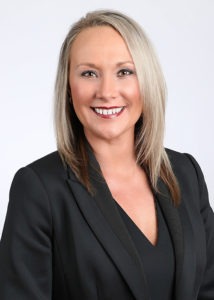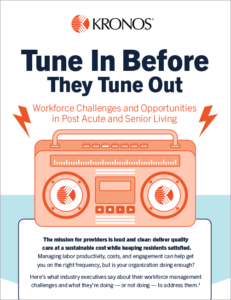Leading a multi-generational staff
Building a cohesive team has its challenges in almost any setting. In any given long-term care facility, team members often span four or five generations: the Veteran or Traditional Generation, Baby Boomers, Generation X, Generation Y (also known as Millennials) and perhaps Generation Z. Each cohort has its own range of life experiences, communication styles, work ethics and expectations for employers, and each seeks rewards and recognition in a different way. In order to implement successful facility initiatives and accomplish organizational goals, nurse leaders must be able to identify and understand these deep-rooted generational differences. Here’s what a multi-generational encounter might look like.
Nurse Sarah and the great clash
Sarah, a 27-year-old RN, is responsible for rolling out the new fall-reduction program in her facility. She decides to assemble a team of staff members to help plan and implement the staff awareness campaign for the new program’s rollout. The task force she chooses includes Dr. Jones, age 58; Andrea, the head of housekeeping, age 46; Daniel, a third-shift CNA, age 19; Jerry, a physical therapist, age 32; and John, a part-time activities coordinator, age 73. She is confident that this diversity will give her campaign a broad reach.
Sarah opens the team meeting by asking for everyone’s thoughts on the best way to inform the staff of the coming changes. Andrea, of Generation X, is the first to raise her hand. She suggests that the team make and wear buttons that say, “Ask me about our new FALL program.” Andrea, who believes in work/life balance and feels that work should be fun, has a creative side and dislikes micromanagement. She volunteers to lend the team her button maker, which will naturally help the facility save money. She believes the buttons will spark conversations about the new program.
Daniel, of Generation Z, immediately rolls his eyes and reaches for his phone to send a text message to his fellow CNAs. Generation Z uses technology like no generation before, and his text includes a disgusted emoji face to help communicate his disdain for the idea. Before Sarah can ask how the group feels about the button idea, he interjects, “I’m not wearing a button, and neither will my shiftmates. I can ask them right now if you like,” he adds, gesturing to his phone, “but we aren’t going to go for this.”
 Jerry, a Millennial, is pragmatic and adaptable, and tries to keep the meeting positive. He jumps in, suggesting that they explain the changes at an employee meeting/party, as an alternative to the floundering button idea, thinking that a party would be fun. Jerry is confident, optimistic and collaborative. He is sure that everyone can play an important role in the party planning, and he volunteers to make a slideshow.
Jerry, a Millennial, is pragmatic and adaptable, and tries to keep the meeting positive. He jumps in, suggesting that they explain the changes at an employee meeting/party, as an alternative to the floundering button idea, thinking that a party would be fun. Jerry is confident, optimistic and collaborative. He is sure that everyone can play an important role in the party planning, and he volunteers to make a slideshow.
Dr. Jones, a Baby Boomer, agrees that the party is a good plan. Dr. Jones enjoys teamwork but can sometimes take over projects, and she is already thinking about the paper handouts she will make to supplement whatever Jerry puts in the slideshow.
John, a Veteran or Traditionalist, keeps quiet but sighs to himself. He doesn’t want to be a disrupter, but he always has trouble reading from the screen, and he is sure others will, too.
Harnessing the power of a multi-generational team
What is any nurse leader like Sarah to do when faced with the struggle of getting team members on the same page? Knowing their differences can assist with building a stronger, more positive and more productive team, note authors C. P. Harvey and M. J. Allard in Understanding and Managing Diversity: readings, Cases and Exercises (2011). While generational characteristics don’t apply to every individual or every situation, team leaders may find some of these basic characteristics helpful in communicating and engaging multi-generational teams.
Veteran or Traditional Generation: Although this group constitutes a very small portion of the workforce since many have retired, some do remain, perhaps as part-time employees or volunteers. Disciplined and hardworking, they respect authority, are extremely loyal, and are often uncomfortable with conflict and change. Sarah might address John apart from the group before or after the meeting, which would help her to express how much she values and respects his experience.
Baby Boomers: Frequently serving as directors of nursing or administrators, Baby Boomers grew up during a time of prosperity. They are committed to working hard, which in many cases has landed them multiple promotions. They are motivated by feeling valued as part of a team, they prize good working relationships and enjoy pleasing others. They are perceived as being competitive and they have a take-charge mentality, often a by-product of a strong work ethic. They don’t always manage work/life balance well and they tend to avoid conflict. Baby Boomers prefer open and direct communication, seek approval and want thorough explanations in answer to their questions. Sarah might best address Dr. Jones by emphasizing how important and unique her contributions are, while encouraging her to see the potential for contributions from others.
Generation X: This era makes up a significant portion of the workforce as RNs and therapists. This group appreciates diversity, believes that work should be fun and tends to have a casual approach to authority. Self-reliant and independent, this generation is not intimidated by authority. Gen-Xers tend to have low expectations about job security, are less willing to make personal sacrifices at work and resist being micromanaged. Sarah might best address Andrea by encouraging her to contribute in the way that feels most comfortable, all the while keeping tabs on her work from a distance.
Generation Y: Also known as Millennials, this age group commonly includes nurses, nursing assistants and therapists. Millennials are confident, optimistic and open-minded, and they value achievement. They prefer email and tech communication. As multitaskers, they prefer supervision, mentoring and structure. They also tend to need feedback and praise and often have a distaste for menial work. This group combines the teamwork ethic of the Boomers with the can-do attitude of the Veterans and the technological savvy of the Gen-Xers. Their learning preferences include teamwork, technology, structure, entertainment and exciting or experiential activities. Sarah might best address Jerry by supporting his idea, providing lots of feedback, using humor and offering encouragement.
Generation Z: This generation might show up among the nursing assistant or ancillary staff (such as activity or dietary aides). Most of the character traits of this generation have yet to fully evolve, but one thing that is clear is the ability to use technology like the generation before, making the preferred communication styles via text messaging, telephone calls or video calls. This group also seems to have more social and environmental awareness than prior generations.
In order to have a cohesive work environment, nurse leaders must manage a workforce made up of multiple generations that often collide with each other. These adversarial energies can impede the flow of work that seeks to implement sustainable change. By being aware of the strengths and assets of each generation and embracing them, nurse leaders can improve communication and encourage a more positive and productive work environment.
Amy Stewart, RN, DNS-MT, RAC-MT, QCP-MT, is Curriculum Development Specialist at the American Association of Directors of Nursing Services (AADNS).
Related Articles
Topics: Articles , Leadership , Staffing











